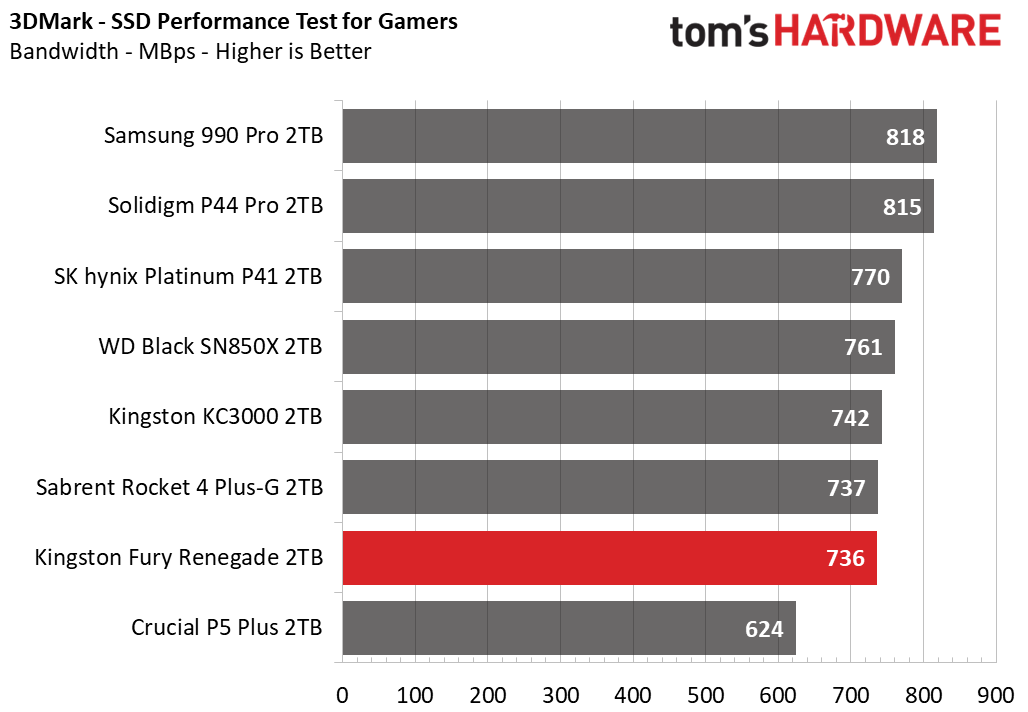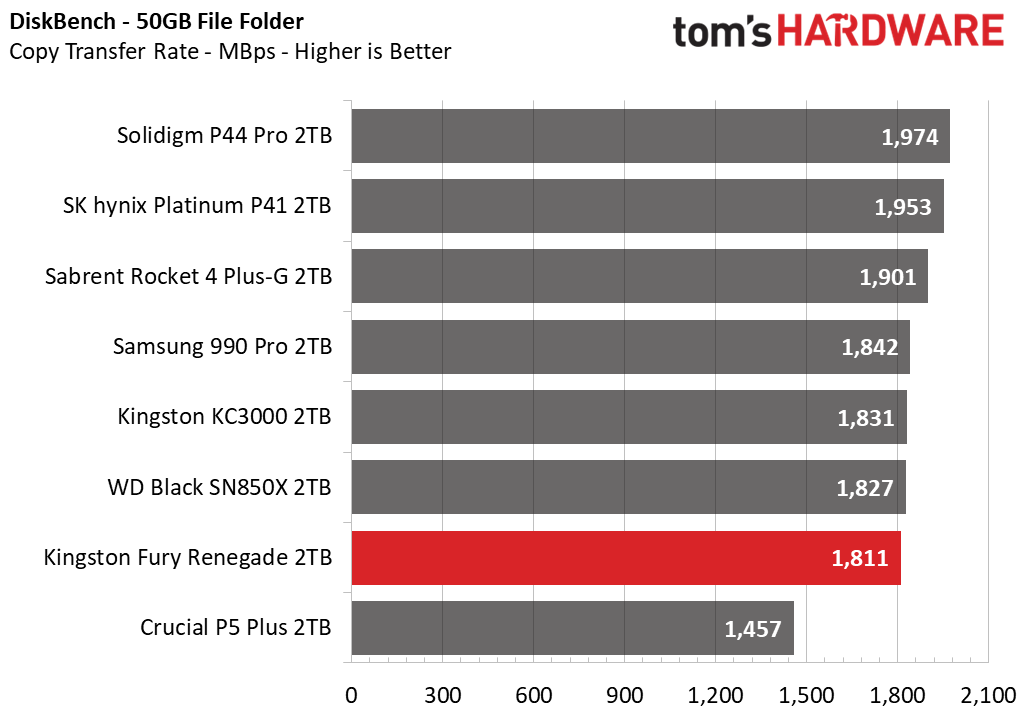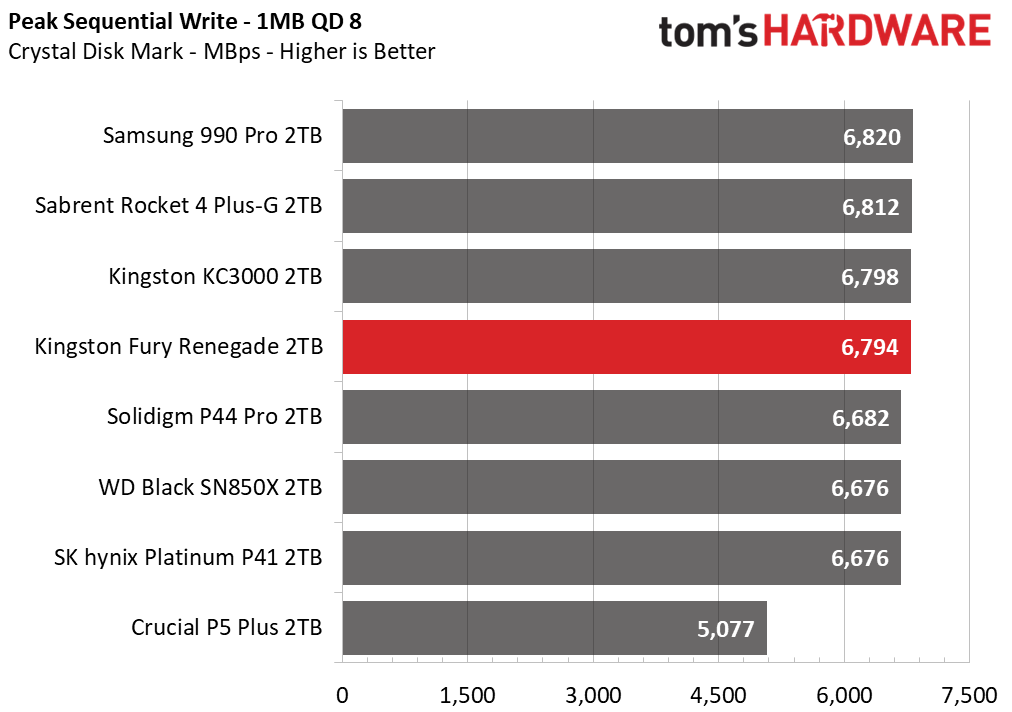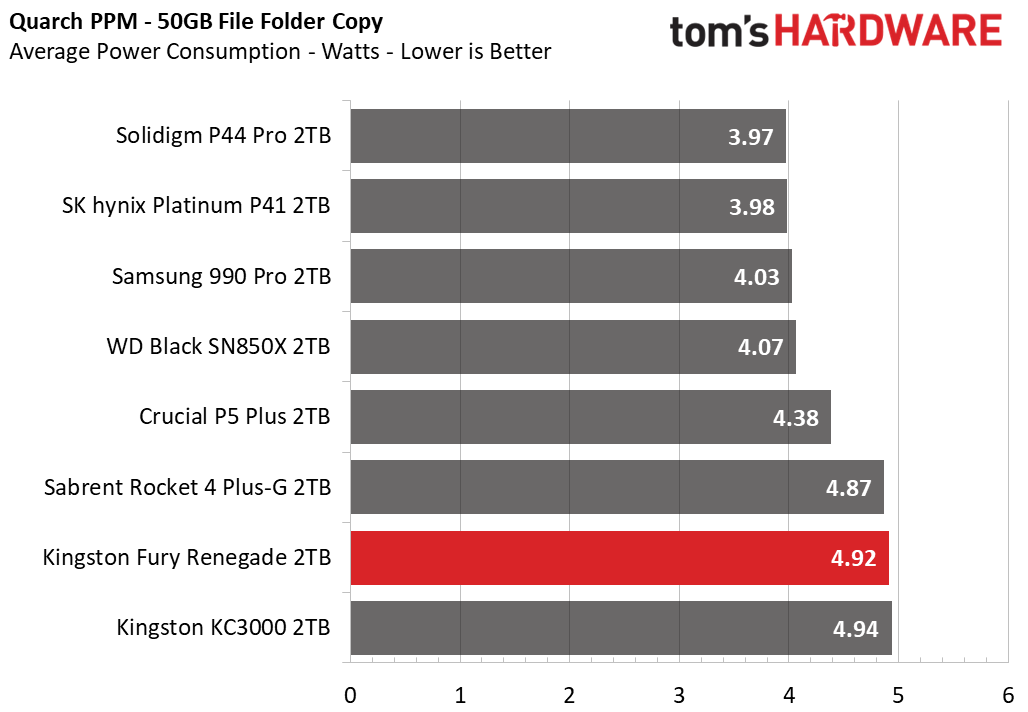Why you can trust Tom's Hardware
Comparison Products
The heatsinked 2TB Kingston Fury Renegade faces the Samsung 990 Pro, the WD Black SN850X, the SK hynix Platinum P41, the Kingston KC3000, the Sabrent Rocket 4 Plus-G, the Crucial P5 Plus, and the Solidigm P44 Pro. This is stiff competition as the original Phison E18 controller on the Fury Renegade begins to show its age, although some drives based on that controller will have Phison’s newer I/O+ firmware - like the Rocket 4 Plus-G.
Trace Testing - 3DMark Storage Benchmark
Built for gamers, 3DMark’s Storage Benchmark focuses on real-world gaming performance. Each round in this benchmark stresses storage based on gaming activities including loading games, saving progress, installing game files, and recording gameplay video streams.



The Fury Renegade is lackluster at best in 3DMark, although it’s not as far back as it appears on the charts. The hardware on this drive is more than a year old, after all
Trace Testing – PCMark 10 Storage Benchmark
PCMark 10 is a trace-based benchmark that uses a wide-ranging set of real-world traces from popular applications and everyday tasks to measure the performance of storage devices.



The Fury Renegade does a little bit better on PCMark but is still essentially outdated at this point. It’s still an incredibly fast drive, but there’s a lot of competition at 2TB.
Transfer Rates – DiskBench
We use the DiskBench storage benchmarking tool to test file transfer performance with a custom, 50GB dataset. We copy 31,227 files of various types, such as pictures, PDFs, and videos to a new folder and then follow-up with a reading test of a newly-written 6.5GB zip file.



The Fury Renegade trails most of the competition but the performance results are close enough together that it’s not a big deal. It’s only the P44 Pro and Platinum P41 that pull away.
Get Tom's Hardware's best news and in-depth reviews, straight to your inbox.
Synthetic Testing - ATTO / CrystalDiskMark
ATTO and CrystalDiskMark (CDM) are free and easy-to-use storage benchmarking tools that SSD vendors commonly use to assign performance specifications to their products. Both of these tools give us insight into how each device handles different file sizes.











The Fury Renegade does quite well in ATTO and with sequential performance in CDM. The Black SN850X and 990 Pro are two drives that have rivaled Phison controllers in ATTO for sequential writes, but in general the Fury Renegade performs very well in ATTO. For 4KB performance in CDM and particularly at low queue depth - which is most relevant for subjective feel - the Fury Renegade is right up there.
The 990 Pro takes the lead with read latency and the P44 Pro with write latency and we might give the nod to the latter overall, but it’s fairly close. The Fury Renegade simply trails some of the newer drives, but real world performance between them is going to be extremely close.
Sustained Write Performance and Cache Recovery
Official write specifications are only part of the performance picture. Most SSDs implement a write cache, which is a fast area of (usually) pseudo-SLC programmed flash that absorbs incoming data.
Sustained write speeds can suffer tremendously once the workload spills outside of the cache and into the "native" TLC or QLC flash. We use Iometer to hammer the SSD with sequential writes for 15 minutes to measure both the size of the write cache and performance after the cache is saturated. We also monitor cache recovery via multiple idle rounds.





The 2TB Fury Renenage maintains the large, dynamic cache of the KC3000. The cache spans the entire breadth of the drive, meaning that all of the native TLC may run in pSLC mode. The precise size will change as the drive is filled. In this performance mode the drive writes up to 6.8 GBps before tumbling down to around 1.7 GBps when folding after the cache is exhausted.
The drive is still able to write quite a lot, rivaling any drive except those with the same controller using a smaller pSLC cache. That group would include the Rocket 4 Plus-G which writes considerably more with higher TLC speeds. Even with its overall write performance being high, the Fury Renegade is not quite as consistent.
The 990 Pro, Platinum P41, and P44 Pro all feel more consistent, which makes sense as they trade off absolute TLC performance. The Black SN850X has a wider cache than these three, but also has algorithms to improve sustained performance consistency. The Rocket 4 Plus-G does, too, thanks to the I/O+ firmware. This is a trend with newer drives as DirectStorage looms on the horizon. It’s also beneficial for hot environments, such as in the PlayStation 5, to prevent unwanted throttling.
Power Consumption and Temperature
We use the Quarch HD Programmable Power Module to gain a deeper understanding of power characteristics. Idle power consumption is an important aspect to consider, especially if you're looking for a laptop upgrade as even the best ultrabooks can have mediocre storage.
Some SSDs can consume watts of power at idle while better-suited ones sip just milliwatts. Average workload power consumption and max consumption are two other aspects of power consumption, but performance-per-watt is more important. A drive might consume more power during any given workload, but accomplishing a task faster allows the drive to drop into an idle state more quickly, ultimately saving energy.
Temperatures are gauged at both idle and load states via sensor and an infrared thermometer. The typical ambient temperature is at 24C. The load state involves sustained writes at maximum speed with measurement ensuing if and until throttling is demonstrated to discover the equilibrium temperature.




The Phison E18 controller is also showing its age with respect to power efficiency as the Fury Renegade has a relatively poor showing in this test. Efficiency is still good enough, particularly as drives are usually idle, but newer technology has demonstrated what is possible with streamlined hardware. The I/O+ firmware does help the Rocket 4 Plus-G do a little bit better than the KC3000 and Fury Renegade.
Of course, the new 2TB Kingston Fury Renegade’s claim to fame is its heatsink. Some of the drives tested here have the option for it, including the 990 Pro and Black SN850X. A heatsink is likely to improve performance in some cases, for example with sustained writes or in a PS5. We generally recommend a heatsink for high-end PCIe 4.0 SSDs.
The Renegade Fury measured 27C at idle and hit above 75C with sustained writes. The drive exhibited some throttling after about 1TB of writes, which is a large amount. The drive’s performance scaled neatly with temperature and the addition of airflow helped keep it from throttling. It’s possible Kingston designed this drive to perform within a tighter thermal envelope to maintain reliability.
This is a logical approach given our comments above for write saturation testing. We would conclude that the new SKU is designed to try and get some legs on this hardware, but it really needs the I/O+ firmware to make the most sense. The firmware does not appear updated on our end.
Test Bench and Testing Notes
| CPU | Intel Core i9-12900K |
| Motherboard | Asus ROG Maximus Z690 Formula |
| Memory | 2x16GB Corsair Dominator DDR5 5600 CL36 |
| Graphics | Intel Iris Xe UHD Graphics 770 |
| CPU Cooling | Arctic Liquid Freezer II - 420 |
| Case | Streacom BC1 Open Benchtable |
| Power Supply | Corsair SF750 Platinum |
| OS Storage | Sabrent Rocket 4 Plus 2TB |
| Operating System | Windows 11 Pro |
We use an Alder Lake platform with most background applications such as indexing, windows updates, and anti-virus disabled in the OS to reduce run-to-run variability. Each SSD is prefilled to 50% capacity and tested as a secondary device. Unless noted, we use active cooling for all SSDs.
MORE: Best SSDs
MORE: Best External SSDs and Hard Drives
MORE: How We Test HDDs And SSDs
MORE: All SSD Content
Current page: 2TB Performance Results
Prev Page Features and Specifications Next Page 1TB Performance Results
Shane Downing is a Freelance Reviewer for Tom’s Hardware US, covering consumer storage hardware.
